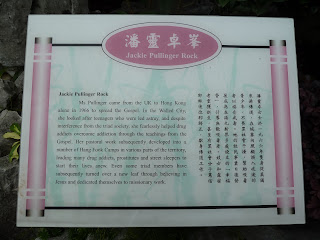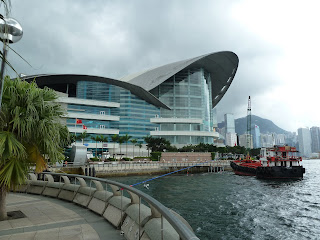Walled fort around 1910
The Walled City was densely populated and a largely ungoverned settlement in Kowloon. In 1898, the New Territories were leased to the British for a term of 99 years. At first, Qing officials still continued to station in the Walled City. In 1899, however, British troops were sent to take over the City, and the Qing officials and soldiers were expelled. The resultant vacuum of civil order from 1899 laid the seeds for the eventual deterioration of the area into a semi-lawless enclave and festering squatter slum.
Kowloon Walled Fort in 1915
During the Japanese occupation of 1941-45 the wall was torn down and the stone used to extend the nearby Kai Tak airfield, which later became Hong Kong's famous international airport.
In the 1950s, Triad groups such as the 14K and Sun Yee On gained a stranglehold on the Walled City's countless brothels, gambling parlours, opium dens and even cheap, unlicensed dentists. The Walled City had become a haven for criminals and violent crime; police would only venture into it in large groups. it wasn't until 1973-74, when a series of more than 3,500 police raids resulted in over 2,500 arrests and over 4,000 pounds of seized drugs, that the Triad's power began to wane. With public support, particularly from younger residents, the continued raids gradually eroded drug use and violent crime. In 1983, the police commander of the Kowloon City District declared the Walled City's crime rate to be under control. In 1987 the Walled City contained 33,000 residents (some sources quote 40,000) within its 6.5-acre area.
The Walled City in 1973 (without the wall of course..)
1973 street picture courtesy of HK Library
1970s aerial view of the city
By 1989 the city had expanded rapidly
1980 showing one of the few internal courtyards
1980
Buildings were typically 12-14 storeys - height restriction due to Kai Tak airport flight path
Internal courtyard
View over rooftops
1980
Buildings were typically 12-14 storeys - height restriction due to Kai Tak airport flight path
Narrow alleyways inside the city were damp and rat infested
Letter boxes along one of the streets
1989 West Side - daylight was rarely able to pierce the ground level, so the city's inhabitants lived in darkness or artificial lighting
A typical streets power supply was overhead, water came from wellsInternal courtyard
View over rooftops
In January 1987 the Hong Kong government announced plans to demolish it, and after a long and arduous eviction process, demolition began in March 1993. Demolition was completed in April 1994 and Kowloon Walled City Park was built in its place, opening on the 22nd December 1995 by the last British Governor of Hong Kong, the Rt Hon. Christopher Pattern.
The park is modelled on Jiangnan gardens of the early Qing Dynasty and is divided into eight landscapes features. The parks paths and pavilions are named after the streets and buildings of the Walled City.
Layout of The Walled City Park as it is today - open from 06:30 to 23:00 daily
Some info on the South Gate - click twice to enlarge
Remnants of the South Gate explained
Remnants of the South Gate
A bronze model of The City
The 'Borg Collective' could have been modeled on this real life underworld and ungoverned city
Side section diagram of the Walled City in great detail
Some info about the Kuixing pavilion and Guibi rock
The gardens are lush and superbly planned
Photo gallery
Pavilion
History of the Walled City
Jackie Pullinger is an amazing woman who at the age of 22 moved from the UK to Hong Kong in 1966. A Christian missionary, upon arrival she sort to convert the inhabitants (triads, drug addicts and prostitutes) of the Walled City to Christianity and get them to give up their ways. Dramatically she more than achieved her goals, converting around 500 people. She set up the St. Stephens Society which still runs today.
Jackie Pullinger
This garden and rock are dedicated to the work that Jackie did in the Walled City
In the Almshouse
The history of the City is well depicted in the park
With videos and interactive exhibitions
If you're in HK, visit the park if you're as captivated by the history as I was..
The City wasn't serviced by water, which had to be gained from wells, pumps & stand-pipes
Location of the Walled City in Kowloon - the park is built on the exact site
Click twice to view me
The city was below the flight path of Kai Tak
Rickshaw
Some of the past inhabitants of the Walled City still frequent the park
Better go now, Police are on their way!
With videos and interactive exhibitions
If you're in HK, visit the park if you're as captivated by the history as I was..
The City wasn't serviced by water, which had to be gained from wells, pumps & stand-pipes
Location of the Walled City in Kowloon - the park is built on the exact site
Click twice to view me
The city was below the flight path of Kai Tak
Rickshaw
Some of the past inhabitants of the Walled City still frequent the park
Better go now, Police are on their way!
I've plundered the internet and purloined some photo's for this blog, I hope the owners don't mind too much..
By far the best source of photo's and information is the brilliant book I purchased on the subject, 'City of Darkness - Life in Kowloon Walled City' by Greg Girard and Ian Lambot.
Additionally, I bought the DVD, 'The law of Love - The Story of Jackie Pullinger' and book called 'Chasing the Dragon' by Jackie Pullinger and Andrew Quicke.
Finally, if you search on YouTube for Kowloon Walled City you'll see some great videos, the four German one's being the best.
Finally, if you search on YouTube for Kowloon Walled City you'll see some great videos, the four German one's being the best.





























































































